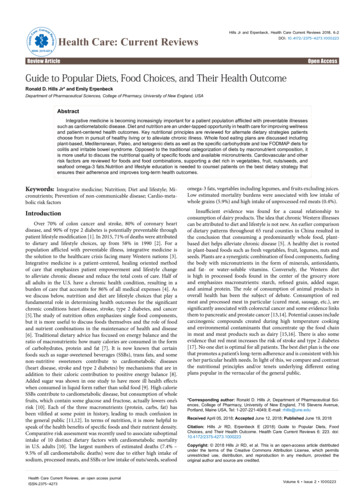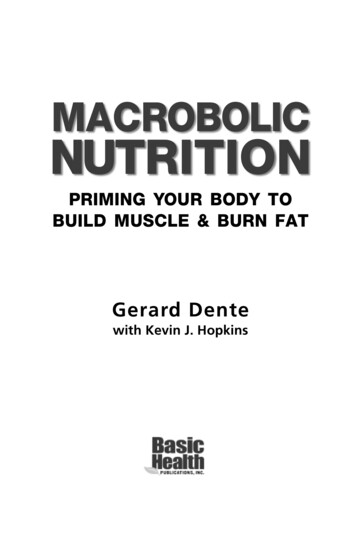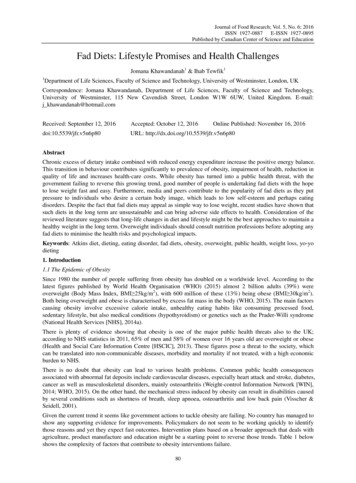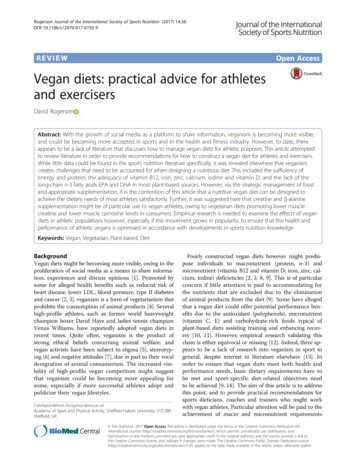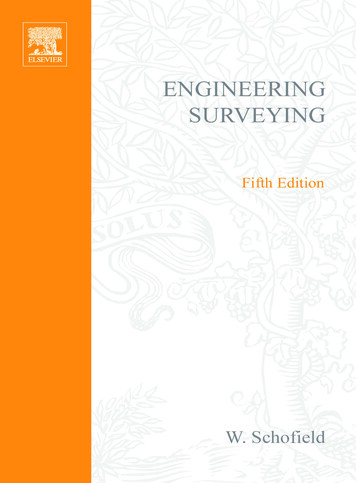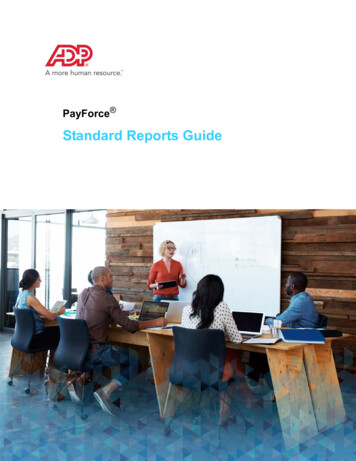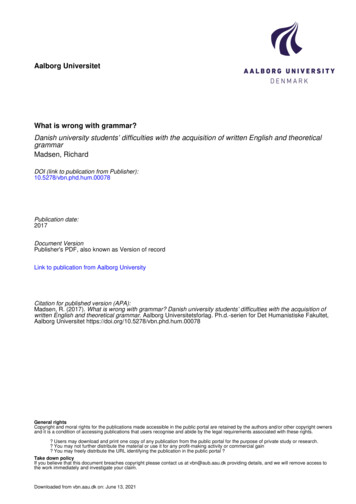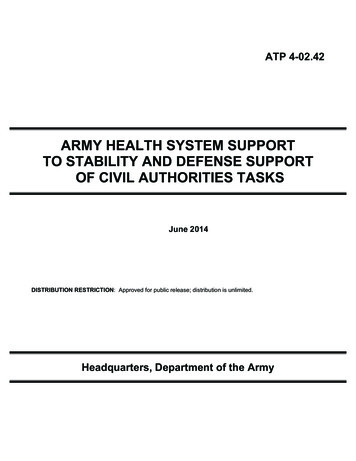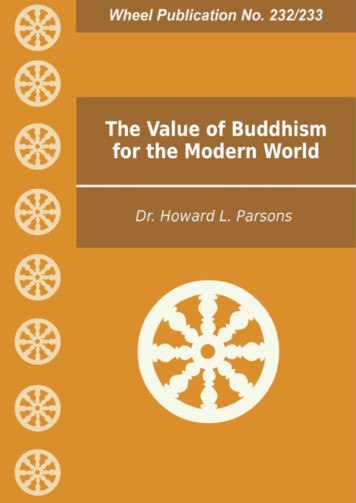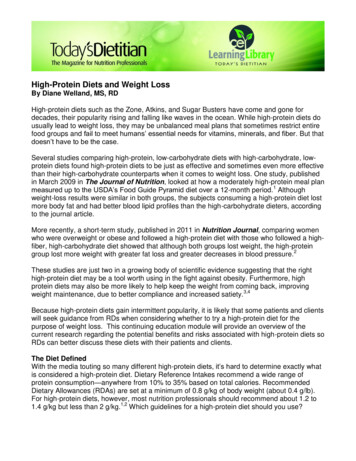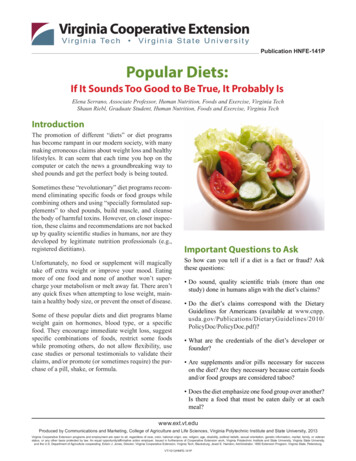
Transcription
Publication HNFE-141PPopular Diets:If It Sounds Too Good to Be True, It Probably IsElena Serrano, Associate Professor, Human Nutrition, Foods and Exercise, Virginia TechShaun Riebl, Graduate Student, Human Nutrition, Foods and Exercise, Virginia TechIntroductionThe promotion of different “diets” or diet programshas become rampant in our modern society, with manymaking erroneous claims about weight loss and healthylifestyles. It can seem that each time you hop on thecomputer or catch the news a groundbreaking way toshed pounds and get the perfect body is being touted.Sometimes these “revolutionary” diet programs recommend eliminating specific foods or food groups whilecombining others and using “specially formulated supplements” to shed pounds, build muscle, and cleansethe body of harmful toxins. However, on closer inspection, these claims and recommendations are not backedup by quality scientific studies in humans, nor are theydeveloped by legitimate nutrition professionals (e.g.,registered dietitians).Unfortunately, no food or supplement will magicallytake off extra weight or improve your mood. Eatingmore of one food and none of another won’t supercharge your metabolism or melt away fat. There aren’tany quick fixes when attempting to lose weight, maintain a healthy body size, or prevent the onset of disease.Some of these popular diets and diet programs blameweight gain on hormones, blood type, or a specificfood. They encourage immediate weight loss, suggestspecific combinations of foods, restrict some foodswhile promoting others, do not allow flexibility, usecase studies or personal testimonials to validate theirclaims, and/or promote (or sometimes require) the purchase of a pill, shake, or formula.Important Questions to AskSo how can you tell if a diet is a fact or fraud? Askthese questions: Do sound, quality scientific trials (more than onestudy) done in humans align with the diet’s claims? Do the diet’s claims correspond with the DietaryGuidelines for Americans (available at 010/PolicyDoc/PolicyDoc.pdf)? What are the credentials of the diet’s developer orfounder? Are supplements and/or pills necessary for successon the diet? Are they necessary because certain foodsand/or food groups are considered taboo? Does the diet emphasize one food group over another?Is there a food that must be eaten daily or at eachmeal?www.ext.vt.eduProduced by Communications and Marketing, College of Agriculture and Life Sciences, Virginia Polytechnic Institute and State University, 2013Virginia Cooperative Extension programs and employment are open to all, regardless of race, color, national origin, sex, religion, age, disability, political beliefs, sexual orientation, genetic information, marital, family, or veteranstatus, or any other basis protected by law. An equal opportunity/affirmative action employer. Issued in furtherance of Cooperative Extension work, Virginia Polytechnic Institute and State University, Virginia State University,and the U.S. Department of Agriculture cooperating. Edwin J. Jones, Director, Virginia Cooperative Extension, Virginia Tech, Blacksburg; Jewel E. Hairston, Administrator, 1890 Extension Program, Virginia State, Petersburg.VT/1013/HNFE-141P
Does the diet start with extreme caloric restriction ora fast? Are dramatic, too-good-to-be-true results promisedover a short period of time? (A healthy and reasonableweight loss is about 1 to 2 pounds per week.) Does the diet highlight both the benefits and risksassociated with it? Are megadoses of specific nutrients, vitamins, orminerals required or recommended?While this list is not exhaustive, it can be used as abasis for assessing the appropriateness of popular diets.Overview of Popular DietsThe table that follows provides a summary of theclaims, pros, and cons of some popular diets. The listis not all-inclusive; however, it can be used as a reference. For further information or counsel on other diettrends, please consult a Virginia Cooperative Extensionfamily and consumer sciences agent. Contact information for local VCE offices can be found at www.ext.vt.edu/offices.www.ext.vt.edu2
DietAtkins dietDescriptionClaims Promisesbetter hearthealth, memoryfunction, andweight loss on adiet of low carbsthat is rich inprotein and fat.Foods to Avoid All foods withrefined sugars. Milk. White rice, flour,and pasta. Potatoes.OK Foods Meat, eggs,cheese, fish, oliveoil. Some wholegrains, fruits, andvegetables (afterfirst two weeks). By drastically Carbs (for thedecreasingfirst two weeks).carbs and eatingincreased proteinand fat will leadto good healthand preventdisease. 1 2-weekprogram oflow carbsand physicalactivity will helpattain health,peak fitness,and maximizewillpower toreach life goals.ProsCons Exercise in allphases. Increasedcholesterol. 1 2 weeks of mealplans. Constipation (fromlack of fiber) andbad breath (fromlack of carb intake,causing ketosis). Allows whatare typicallyconsidered“forbidden” or“cheat” foods (e.g.,cream, high fat,meat, butter). Recommendssupplementsbecause notgetting enoughnutrients fromfoods like fruitsand vegetablesand to preventdizziness, fatigue,and leg cramps. May promote heartdisease, strokes,and cancer. Very restrictive/limited. Less than minimalcarbs for brainfunction (i.e., 130grams per day). No scientificliterature to verifyclaims and mainlypersonal accounts(i.e., anecdotal)or testimonialsare used to justifyclaims of increasedenergy, betterconcentration,decreased cravings,increased mood,and decreaseddepressivesymptoms.www.ext.vt.edu3
Diet“BiggestLoser” dietDescriptionClaims Low-calorie dietbased on fruits,vegetables, leanprotein, andphysical activity. Will decreaseblood pressure,cholesterol,weight, andincrease energy.Foods to AvoidOK Foods White bread,regular pasta,potatoes. Fruit, vegetables. Refined sugarsand grains. Lean protein. Whole grains. Foods withoutadded sugars, fat,and salt. Healthy fats (e.g.,olive oil, canolaoil, flax seed oil,nuts, seeds).Pros Monitoring withdaily food logs. Monitoring ofportion sizes. Daily exercise.Cons May not beenough carbs forsome people. Inaccurate methodto estimate calorierequirements. Promotes 48-64 Many not beounces daily wateradequate caloriesintake.(e.g., 1,050 caloriesfor a 150-pound Fruit andperson).vegetablesrecommended Questionableover juice andcalcium intake.dried fruit. Whole grainswith specific fiberrecommendations. Support (social). Increased fiberintake. Small, frequentmeals.www.ext.vt.edu4
DietBlood typediet (“EatRight for YourBlood Type”)DescriptionClaimsFoods to Avoid Blood type Depends onaffects digestionblood type, butand some foodscan includeare dangerous ifchicken, beef,not right for yourpork, wheat,blood type.corn, lentils,grains, breads, If you eat thelegumes, wholewrong foods forwheat, andyour blood type,wheat germ.it can slow yourmetabolism,causeinflammation,bloating, anddiseases likecancer.OK Foods Depends onblood type, butcan include leanmeats, poultry,fish. Soy protein. Grains. Organicvegetables.Pros Fruit andvegetableconsumption. Lean sources ofprotein.Cons Very restrictive. No science to backit up. Not individualizedfor preferences orneeds. May lack dairy. Tofu. Dairy. Some foods actas poisons whileothers are “highlybeneficial” or“neutral.” Blood typeimpacts how youshould exercise.www.ext.vt.edu5
DietDetox dietsDescriptionClaims Removing toxinswill promotedecreasedweight andoptimal bodyfunctioningand boostmetabolism. Somerecommend“cleanses” viasupplementsand enemas.Foods to Avoid Varies accordingto diet. Typically dairy,eggs, grains(oats, corn,wheat).OK Foods Fruits andvegetables (afterinitial fast). Water.Pros Avoidance ofprocessed foodsand foods high insugar and fat.Cons No scientificevidence backingmethods used indiets; based ontestimonials. Promises a quickfix. Pork, beef,sausage. Supplementswith unknownor questionableingredients. Nuts, seeds, oils. Alcohol. Electrolyteimbalances. Typically startswith a fastfollowed byreintroductionof fruit andvegetables,water, andsupplements. May slowmetabolismbecause so low incalories. Fatigue, nausea,vomiting, bloating. Toxins stay in ourbodies, causingfatigue, digestiveproblems, andother healthproblems. Causes publicto think that ourbodies cannotproperly ridthemselves oftoxins. Decreased proteinintake. Unsupervised useof enemas.www.ext.vt.edu6
DietDescriptionClaimsFoods to AvoidGrapefruit diet Claims grapefruit All fruit excepthas an enzymegrapefruit.that, when eaten All grains.with fats andhigh-protein Corn, carrots,foods, increasesbeans, peas.fat burning,resulting in High-carb saladweight loss.dressing. 1 2-day planpromises a10-pound weightloss by eating1/2 grapefruitor specifiedamount of 100%grapefruit juicebefore eachmeal.OK FoodsPros Nonstarchy Promotes watervegetablesconsumption.(lettuces, Good amountbroccoli, bellof vitamin C andpeppers, zucchini,fiber.cucumbers). Salt. Cheese. Nuts. Some high-fatmeats (e.g.,bacon).Cons Rapid weight loss. Insufficientcalories. Limits grains andsome fruits. Meals may be easy Snacking only afterto prepare.dinner. Sufficient Limited amountsvegetables.of foods to choosefrom/lacks variety. Low-carb saladdressing. Meals are thesame each day ofthe diet, differingonly in the type/source of proteineaten at lunchand dinner.www.ext.vt.edu7
DietJenny CraigDescriptionClaimsFoods to Avoid Three-level None.program todecrease weightand keep it offusing a balanceddiet and regularphysical activity. Starts withprepackagedmeals withultimate goal ofhaving peoplepurchase andprepare mealsthemselves.OK Foods All foods inmoderation withemphasis onfruits, vegetables,whole grains,low-fat dairy,unlimitednonstarchyvegetables.ProsCons Certifiedprofessionals“advise” theprogram. Questionableabout learningportion sizesbecause it’s hard tocompare real foods Teaches portionto the portionssize, meal planningin prepackagedand preparation,meals.and how to dealwith eating out. Support staff notnecessarily dietetic Dedicatedprofessionals.to weightmaintenance,addressingbehavioral aspectof foods, andexercise. Extensive support.www.ext.vt.edu8
DietDescriptionClaimsMediterranean Not a diet but away of life thatdietFoods to AvoidOK Foods Saturatedfat, sodium,sweets, meat(not necessarilyavoid them, butlimit to smallamounts). Fruits, vegetables,beans, wholegrains, extravirgin olive oil,yogurt, fish,poultry, eggs,some cheese.provides amplehealthy fats andplant foods withregular physicalactivity that willimprove heart Processed foods.health anddecrease the risk Fried foods.of cardiovasculardisease, cancer,obesity, anddiabetes.Pros Includes healthyfats. Physical activity. Many antioxidants,minerals, vitamins.Cons Food preparation. Not necessarilyused for weightloss. Decreasedsaturated fat andadded sugars. Includes lifestyleaspect. Palatable (tastesgood). Some studiesshow decreasedtotal cholesterol,triglycerides,blood pressure,and LDLcholesterol;increased HDLcholesterol. Decreased intakeof refined grains,high-fat dairy, andred meat.www.ext.vt.edu9
DietNutrisystemDescriptionClaimsFoods to AvoidOK Foods Claims to be Sugar, white Fruit, vegetables,a convenient,bread, cakes,milk, lean protein.healthy weightprocessed foods,managementalcohol.program thatprovides avariety ofmicrowaveready foodselections topromote betterblood sugarcontrol; decreasecravings andfat intake; andincrease fiber,lean proteinconsumption,and feelings offullness. Pre-portioned,frozen foodselections aredelivered to aperson’s homeon a monthlybasis.Pros Decreased intakeof saturated andtrans fats andsodium. Variety of foods. Portion control. Convenient. Rich in wholegrains and(potentially) fiber. Can beindividualizedfor vegetariansand those withdiabetes.Cons Maybe not enoughcalories. Questionablelearning mealpreparationtechniques andportion sizes. May not besustainablebecauseparticipants donot learn how todo things on theirown. Because noweighing,counting, orcooking of foods No weighing,is required, itcounting, cookingmay discourage(takes the thinkinglearning basicout of mealmeal planning andplanning).food preparation Counseling withskills needed to“health advisor.”maintain a healthyweight. Encouragessnacking. Support (online,phone, behaviorguide, andexercise CD).www.ext.vt.edu10
DietPaleo(caveman)dietDescriptionClaimsFoods to AvoidOK FoodsPros Eating planbased on foodthat cavemen/ancestors atethousands ofyears ago. Whole grains. Vegetables. Legumes. Roots. Vitamin B-1 2 andiron from leanprotein. Dairy. Fruits (some). Increased fiber. Sugar. Eggs. Our bodies arebiologicallymade to eatplants and wildanimals. Processed oils. Meat. Decreased fat, salt/sodium, sugar. Potatoes. Fish/shellfish. Salt. Water. Promotes healthand decreasesthe incidence ofchronic disease. Coconut water. Organic green tea. Diet soda.Cons Restrictive andalmost impossibleto truly eat like acaveman. No dairy, wholegrains, legumes. Eliminates foodgroups. Can leadto nutrientdeficiencies iffollowed longterm (calcium andvitamin D). Claims our geneshaven’t adaptedto digest thefoods wehave availabletoday that cancontribute toinflammation,which leads todisease. Typical dietcauses obesity,diabetes, heartdisease. Some versionsencouragefasting andelimination ofsome fruits andvegetables. If you can hunt it,pick it, or grow it,you can eat it.www.ext.vt.edu11
DietPersonalitydietDescriptionClaimsFoods to AvoidOK Foods Not a one-size Red meat. Note:fits-all diet thatLean red meatis primarilyis permitted butplant-basednot encouraged.and cataloguesa personinto certainpersonalitycategoriesdepending onanswers to 60 questions relatedto behaviors andbeliefs towarddealing withconflict, exercise,and eating(e.g., nighttimenibbler,unguidedgrazer, fruitlesseater, mindlessmuncher). Soy products. Seeds and nuts. Fruits andvegetables. Whole grains. Lean poultry. Fish.ProsCons Looks at beneficialaspects of foodintake, whichmay be the rootof disorderedeating patterns(addresses therelationship withfood). Some relationshipswith food maybe rooted indeeper emotionalstressors and needmore in-depthcounseling. Personalized onage and weight. May not besuitable for peoplewho like meat. Flexible. Decreased fatintake. Aims to answerwhy we eat likewe do or why westart exercisingbut tend to giveup? Attemptsto find reasonsand fix them,resulting in alifestyle thatencompassesweight lossand longterm weightmaintenance.www.ext.vt.edu12
DietRaw food diet(rawism)DescriptionClaims Plant foods inunprocessed,uncooked formare best for thebody.Foods to Avoid Alcohol. Sprouts. Refined sugars. Whole grains. Caffeine. Beans. Seaweed. Cook using fooddehydrators withtemperatures notexceeding 118 F because highheat removesvitamins andenzymesnecessary fordigestion.South Beachdiet Americans arecarb crazy, sothe diet’s firsttwo-week phaseis meant todecrease carbcravings. Nuts. Dried fruit. Can beconsidered a“heart healthy”Atkins diet.Pros Decreased riskof developingbladder, stomach,throat, and mouthcancers. Better bloodglucose control. Decreasedcholesterol. Increased fiberintake. Decreased intakeof sugar and fat. Unhealthy fats(e.g., trans,saturated fats). Avoid foodsfor the firsttwo weeks,then highly Promisesdiscouragesto makepotatoes, fruit,participantsbread, cereal,want to eat lessrice, pasta, beets,and better foods.corn, carrots. Uses theglycemic indexto justify makingcarbohydrate/food choices.OK Foods Healthy Promotesfats (poly-/snacking.monounsaturated Variety offats from nuts,prepackagedseeds, oils).foods (snack bars, Low-sugar carbs.frozen meals)available at mostfood markets. Emphasis onnormal portionsand no gorging.Cons Time for mealpreparation. It’s the body thatmakes enzymes fordigestion, not thefood we put intoour body. Cooking foodbelow 118 F maynot destroy foodborne bacteria. Potentiallyinsufficient vitaminB-1 2, omega-3,calcium, iron, orprotein intake. Restrictive evenafter initial twoweek phase. Introductoryphase maycause electrolytedisturbances. Not individualized. Rich in fruits,vegetables, leanprotein. Alcohol. Tomatoes andonions (limitedduring initialphase, but OKthereafter). Whole grainspermitted.www.ext.vt.edu13
Diet“SugarBusters!” dietDescriptionClaimsFoods to Avoid Claims that sugar Any food withis toxic and byrefined sugar.avoiding sugary/ Potatoes; corn;high-glycemicwhite rice, pasta,index foods, fatand bread;will be burned,corn syrup;insulin resistancebeer; sugaryand cholesterolbeverages;will decrease,carrots; beets;energy will soar,ripe bananas;and optimalraisins; bacon;wellness will befried chicken;achieved.cold cuts.OK Foods Fibrousvegetables. Stone-groundwhole grains. Lean protein. Some fruit. Dairy. Some cerealswithout addedsugar.ProsCons Focus on portion Authors contendsizes to cut caloriesthat calories do not(no countingcause weight gaincalories).or loss and thatexercise will not be Encourages use ofbeneficial if sugaryhealthy fats andfoods are eaten.methods of mealpreparation. Snacking withrestrictions (e.g., Snacking isfruits and nutspromoted (withrecommended, butrestrictions; seethey must not beCons).combined). Diet alone doesnot cause insulinresistance.www.ext.vt.edu14
)DescriptionClaims “Safe, effective,and steadyweight lossprogram usingcutting-edgeweight lossscience.”Foods to Avoid None.OK Foods All, whileencouraging“power foods,”like fruits andvegetables, lowfat dairy, leanprotein. Old pointssystem updatedwith “PointsPlus,”which allotspoints in a newway, accountingfor foods withincreased fiberand proteinto encouragesatisfaction andhealthy weightloss.Pros Balancednutritionally. Slow, healthyweight loss. Holistic aspects(i.e., behaviormodification,exercise, diet, andsocial supportare part of theprogram).Cons Individual activitylevel may not beconsidered inpoints system. Fruit can bea source ofsignificant calories. Manycommerciallyavailable foods. Individualizedcalorie level basedon age, weight,gender, height. Fruits andvegetablesare free foodsto encouragegreaterconsumption. Follows theInstitute ofMedicinemacronutrientdistribution. Flexibility. Can be online,in-person orboth. Pocket guide,online, database,and phone appsavailable forsupport. All foods can fitinto a certainindividualizedcalorie range.www.ext.vt.edu15
DietWheat bellydiet, G-free(gluten-free)dietDescriptionClaims Wheat isaddictive,causinguncontrolledeating andwithdrawalsymptoms if it isnot consumed. Author of “WheatBelly,” Dr. WilliamDavis, contendsthat diabetes,insomnia, jointpain, asthma,and acid refluxcan be cured byavoiding wheat. Wheat is thecause of centralobesity and fatstorage becausethe gluten intoday’s wheat isresponsible forthe increase inceliac diseaseand otherinflammatorydiseases.Foods to AvoidOK Foods Processedsnacks. Fish, poultry,eggs. All sourcesof wheat andwheat flour. Nuts. Rye. Barley. Oats. Bread and pasta. Nonstarchyvegetables. Limited fruits (e.g.,2 strawberries, 10blueberries). Rice.Pros Decreasedprocessed, highsugar and -fatfoods. Healthy fats.Cons Limited wholegrains. Evidence is basedon small samplesize and containedseveral limitations. Gluten-freedoes not meandecreased calories,sugar, and fat. Legumes andbeans (limitedto only 1/2 cupserving). Potentialnutritionaldeficiencies(iron, B-vitamins,calcium,magnesium,vitamin D, andfiber). Dried fruit. Cost of foods. Cookies. Some studiesshow that noteating glutenmay actually beassociated withweight gain. Non-cheesedairy. Quinoa. Cheese. Crackers. Cream of Wheat,breakfast cereals. Soy andvegetarianproducts. Other researchsuggests thatwheat and starchesin wheat helpto make goodgut bacteria soavoidance of wheatcan be detrimentalto digestion andsome other healthconditions. Claims thateliminating Processed meats.gluten/wheatwill boost energy Potatoes, cornand improvemeal, rice flour.attention. Can be similar toother low-carbdiets Highly restrictive.www.ext.vt.edu16
charge your metabolism or melt away fat. There aren’t any quick fixes when attempting to lose weight, main-tain a healthy body size, or prevent the onset of disease. Some of these popular diets and diet programs blame weight gain on hormones, blood type, or a spe
